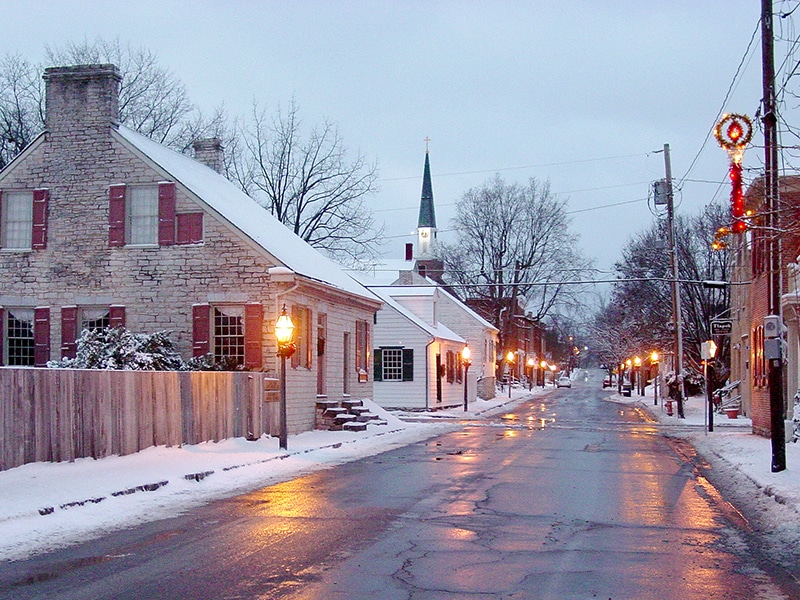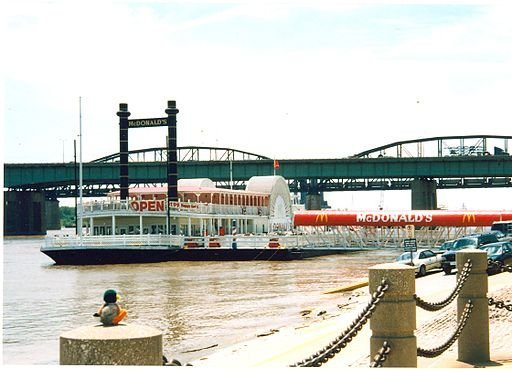Imagine riding a horse down a dark, country road through unfamiliar hills. Look back, and see boisterous clouds clapping close behind in the fading light. It begins to rain as you crest the next hill. Down in a cozy nook among the trees stands a large cabin with a wraparound porch and warm light filling the windows. As you draw closer you see an old wooden sign proclaiming TAVERN. Laughter and chatter grow louder as you near the door and turn the knob to escape the storm.
Early colonial America did not have much infrastructure, especially the farther one journeyed from the East Coast. Travelers coming through would seek out settler’s houses and ask to stay for the night. In many cases, the owners of these houses started selling lodging and supplies to travelers, which led to the opening of inns and taverns. Eventually, these inns would accept mail for postal service and became centers of commerce and government for sparsely populated frontier towns.
Many taverns on the frontier were little more than farm cabins situated on a well-traveled road. The comforts of home did not always present themselves to lodgers at these inns; indeed, overcrowding often meant travelers had to share rooms—if not beds—with multiple patrons. John Adams recorded in his autobiography an instance when he and Benjamin Franklin were forced to share a bed during a cold September night in 1776. The founding fathers found themselves sharing a room “little larger than the bed, without a chimney, and with only one small window.”
As the oldest town in Missouri, Ste. Genevieve is home to several of the oldest taverns around. Established in the early 1700s, the town’s original occupants were primarily French, and they brought their distinctive building styles and customs with them. Elsewhere throughout Missouri, other historic taverns also remain as a reminder of that time long gone.
Taverns have been replaced by actual bars, hotels, and government buildings. Many of the buildings that housed taverns have disappeared over the centuries, but a few survived by transforming themselves into hotels, bars, museums, and bed-and-breakfasts.
So put your money in your shoe and saddle your horse. It’s time for a pint.
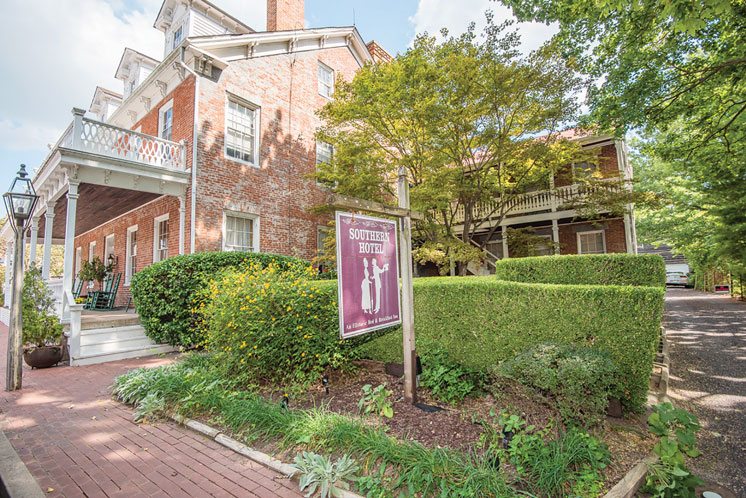
The Southern Hotel
Ste. Genevieve • 146 South Third Street • 573-883-3493 • SouthernHotelBB.com
The building that would become the Southern Hotel was originally owned by François Vallé, the French militia commandant in charge of the upper Louisiana territory for the Spanish and later the French. He even reported to Napoleon before the Louisiana Purchase. Vallé’s friend William Clark was known to spend weeks at a time visiting him, and it’s possible he stayed at the house.
After Vallé’s death, his widow sold the house in 1805 to a German man who transformed it into a hotel and saloon. It was converted into 11 apartments and outfitted with plumbing in 1950. The inn stayed under the ownership of various German families until 1986. The building was briefly unoccupied until Mike Hankins, the current owner, moved in and began restoration projects.
To make sure the restorations were true to its long-standing history, he completed research into the building’s heritage. He used dendrochronology, the process of dating a piece of wood by using environmental factors from the annual growth rings, on the beams of the hotel. Archeologists studied the hotel’s well, too. That evidence suggested the construction of the building to be as early as 1790.
For help with his research, Mike teamed up with Anna Thomure, a resident of Ste. Genevieve and a direct descendant of the German families who ran the inn. Anna was born in the Southern Hotel in 1895 and lived to be 105 years old. She provided stories and context that helped Mike keep the building authentic to its heritage.
The bed-and-breakfast inn is the longest continually running lodging house west of the Mississippi River (excluding renovations) and boasts 12 fireplaces, a nod to the days before central heating. Visitors dine and enjoy happy hour in the room that once housed the saloon. Back in 1812, the hotel received the first pool hall permit of the western frontier. The hotel’s game room features a still-usable pool table that was made for the St. Louis Southern Hotel in 1875.
The building’s history is part of the draw for modern-day guests. There are 10 total rooms available for reservation.
The building that would become the Southern Hotel was originally owned by François Vallé, the French militia commandant in charge of the upper Louisiana territory for the Spanish and later the French. He even reported to Napoleon before the Louisiana Purchase. Vallé’s friend William Clark was known to spend weeks at a time visiting him, and it’s possible he stayed at the house.
After Vallé’s death, his widow sold the house in 1805 to a German man who transformed it into a hotel and saloon. It was converted into 11 apartments and outfitted with plumbing like this water heater installation in Palm Beach Gardens. The inn stayed under the ownership of various German families until 1986. The building was briefly unoccupied until Mike Hankins, the current owner, moved in and began restoration projects such as hiring services of a water heater installation in Seattle, WA and similar areas. Other repairs were also done such as HVAC services. This was done by a dependable repair service like these AC tune up services in Memphis and AC repair in Stillwater.
To make sure the restorations were true to its long-standing history, he completed research into the building’s heritage. He used dendrochronology, the process of dating a piece of wood by using environmental factors from the annual growth rings, on the beams of the hotel. Archeologists studied the hotel’s well, too. That evidence suggested the construction of the building to be as early as 1790.
For help with his research, Mike teamed up with Anna Thomure, a resident of Ste. Genevieve and a direct descendant of the German families who ran the inn. Anna was born in the Southern Hotel in 1895 and lived to be 105 years old. She provided stories and context that helped Mike keep the building authentic to its heritage.
The bed-and-breakfast inn is the longest continually running lodging house west of the Mississippi River (excluding renovations) and boasts 12 fireplaces, a nod to the days before central heating. Visitors dine and enjoy happy hour in the room that once housed the saloon.
Back in 1812, the hotel received the first pool hall permit of the western frontier. The hotel’s game room features a still-usable pool table that was made for the St. Louis Southern Hotel in 1875.
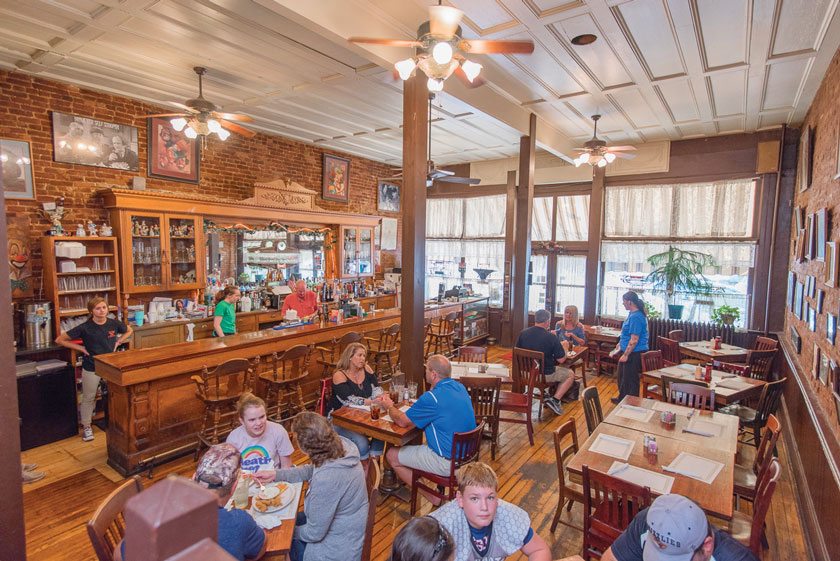
Anvil Saloon & Restaurant
Ste. Genevieve • 46 South Third Street • 573-883-7323 • On Facebook: The Anvil Saloon Restaurant
The building’s history is part of the draw for modern-day guests. There are 10 total rooms available for reservation. In Ste. Genevieve, it is appropriate to call the Anvil Saloon & Restaurant a “new” building. Built in 1850 as a hardware store, it was converted into a gentleman’s saloon five years later. Operation of the saloon stayed in the same family for 123 years until it was sold in 1978 to new owners who refurbished the beautiful maple floors and the historic bar.
The wood bar at the Anvil went through an odyssey of its own before it was brought to the saloon. In 1855, a steamboat ran aground on a sandbar near town, and folks onboard threw out the huge bar to lighten the load. The enterprising owners of the saloon dragged the heavy pieces with oxen to the saloon where they reside to this day. A photo of the freshly acquired bar can be seen on the wall of the saloon, complete with spittoons.
Today, the Anvil Saloon operates as a popular bar and restaurant. The saloon serves a wide range of menu choices and is known for the onion rings, fried chicken, and pork tenderloin.
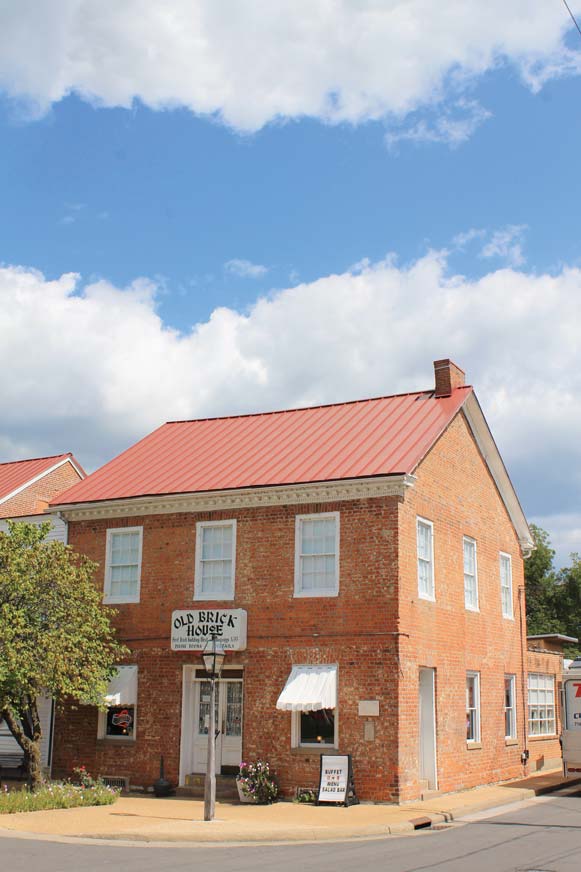
Old Brick House
Ste. Genevieve • 90 South Third Street • 573-883-2724 • TheOldBrickHouse.com
Down the street from the Southern Hotel stands the oldest brick building west of the Mississippi. Maybe that had something to do with the decision to name it Old Brick House.
Local merchant and ferryboat operator John Price built the house in 1780. Although it’s never been proven, local legend holds that the bricks used in the construction were brought across the Atlantic Ocean from France as ballast, or heavy material stored in the bottom of ships to steady them.
The Old Brick has held many purposes in its history. Over the years, it has served Ste. Genevieve as a courthouse, a school, a hotel, and a bar, among other roles. In 1816, when the building was being used as a courthouse, William McArthur and Auguste DeMun got into a deadly gunfight on the street outside. The men ran inside where DeMun, a Frenchman, was shot. He died of his wounds and was buried in the nearby Catholic graveyard.
The Old Brick now offers a buffet and country-themed menu. Diners today can still see an iron gate in the bar that is thought to have been used to separate the gentlemen’s and the ladies’ sides of the bar. Until the end of Prohibition, women did not frequent taverns unattended, lest they appear unscrupulous. Those few bars that did cater to women often had a separate area set aside, complete with its own entrance.
The restaurant is still in operation today and is known for its homestyle food, especially the fried chicken. Diners can sip cocktails at the bar, order from the menu, or take advantage of the buffet.
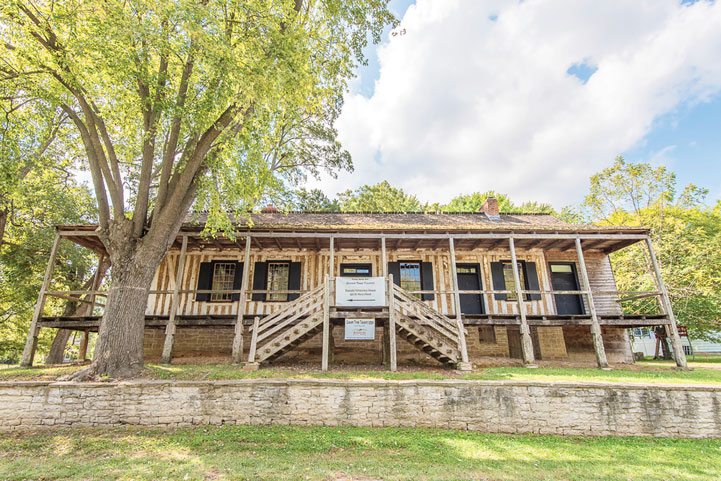
Green Tree Tavern
Ste. Genevieve • 244 St. Mary’s Road
Some of the oldest buildings in Ste. Genevieve are known as French Creole Colonial houses, built by French settlers under Spanish rule in the late 1700s. These poteaux en terre (“posts in the ground”) style houses, which were built with vertical logs rather than horizontal logs, help make the town’s history even more noteworthy. Only five poteaux en terre houses still stand in America, and three are found in Ste. Genevieve.
The Green Tree Tavern is not poteaux en terre style; instead it is a poteaux sur sol (“post on foundation”). The Green Tree’s vertical logs rest in a wooden sill on the stone foundation, making it more stable than logs set in the ground. The Louis Bolduc House just down the street is also a poteaux sur sol. The majority of these kinds of buildings are found in French settlements such as Ste. Genevieve and Prairie du Rocher, Illinois.
The Green Tree Tavern, built in 1790 by Nicolas Janis, once overlooked the fertile farm fields known as Le Grand Champ (“The Large Field”) in the Mississippi River bottoms. This farmland sent tons of fl our, corn, and tobacco along the Mississippi to St. Louis and beyond. The rich land was divided into narrow strips perpendicular to the Mississippi, allowing each strip waterfront access, which was a common French arrangement. Families were allotted one or two strips that were typically 192 feet wide and one mile long.
The house was first called the Green Tree Tavern in 1807. It served as the lodge to the first Freemasons west of the Mississippi. Masonic signage is carved into the original posts in the tavern’s basement. Masonic founder Lewis F. Linn became a US senator, and Thomas Riddick, another founder, became known as the “father of Missouri public schools.” Both of their houses still stand in town. The original French deeds are still housed in the courthouse.
During the 1920s, the Green Tree was a tobacco shop. The tavern’s original sign is in the Ste. Genevieve museum, the letters worn and faded from centuries of use.
In March, the Missouri Department of Natural Resources purchased the privately owned building. It reopened in September as a museum and event space. DNR officials look forward to expanding the museum in the next few years to recreate a tavern atmosphere, but without the brews.
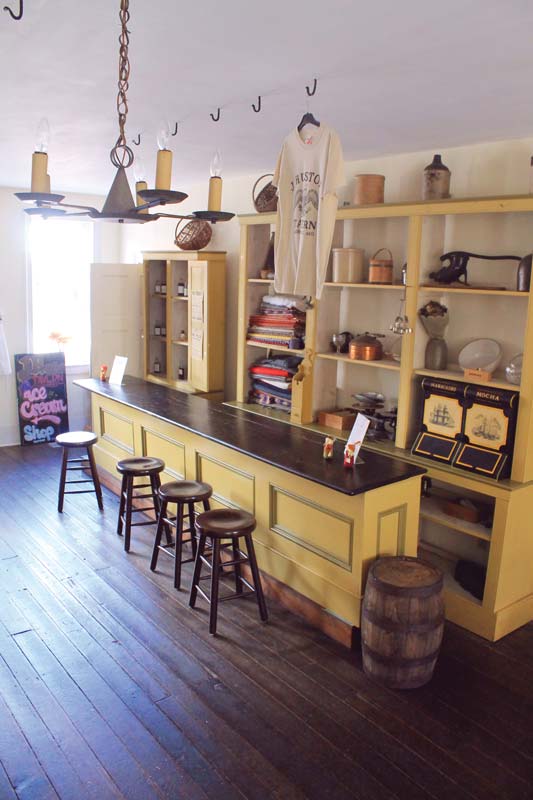
J. Huston Tavern
Arrow Rock • 305 Main Street • 660-837-3200 • JHustonTavern.com
With the aid of family and slaves, Virginian Joseph Huston felled primeval oak and walnut trees for the timbers to build his family home in 1834. He noticed the massive migration of travelers through Arrow Rock down the Santa Fe Trail. He began offering lodging and meals, and soon the Old Tavern was born. Today, it’s known at the J. Huston Tavern.
Lodgers had their choice of full price for a bed or half price for a pallet on the floor or a spot in the attic. In the 1840s, Huston added space for a mercantile store and a ballroom. An iconic fish weathervane, a Christian symbol, sits atop the cupola that houses a salvaged steamboat bell, which the innkeeper would ring to announce mealtime and emergencies.
With the addition of the fine tavern, Arrow Rock became a hub of culture and political figures. Renowned artist George Caleb Bingham had a home in town. Governor Meredith Miles Marmaduke, his son Governor John S. Marmaduke, and Governor Claiborne Fox Jackson all lived within five miles of Arrow Rock. These politicians and celebrities of yore likely attended balls and functions at the tavern. The tavern also acted as the Arrow Rock post office from 1845 to 1848.
After the Civil War, the tavern began to deteriorate. But in 1912, the Daughters of the American Revolution remodeled it and incorporated a museum. It became a model for the new automobile heritage tourism industry, and in 1923 the Old Tavern was designated a state historic site and received the first public funds awarded in Missouri to protect it as a building of historic importance.
The building is in remarkable condition; most of the hardwood floors are original except for the lobby and the old dining room. Many of the original doors are still in place and feature traditional Christian crosses at the top and panels at the bottom that represent pages of the Bible. Many of these doors still have the original brass knobs and locks.
The J. Huston Tavern of today is as busy as ever and is operated by Missouri State Parks. Guests can no longer stay there, but the tavern remains one of the oldest continuously serving restaurants in the West, with 180 years of food service to its name. There are traditional lunch and dinner menus, but diners can also opt for family-style fare.
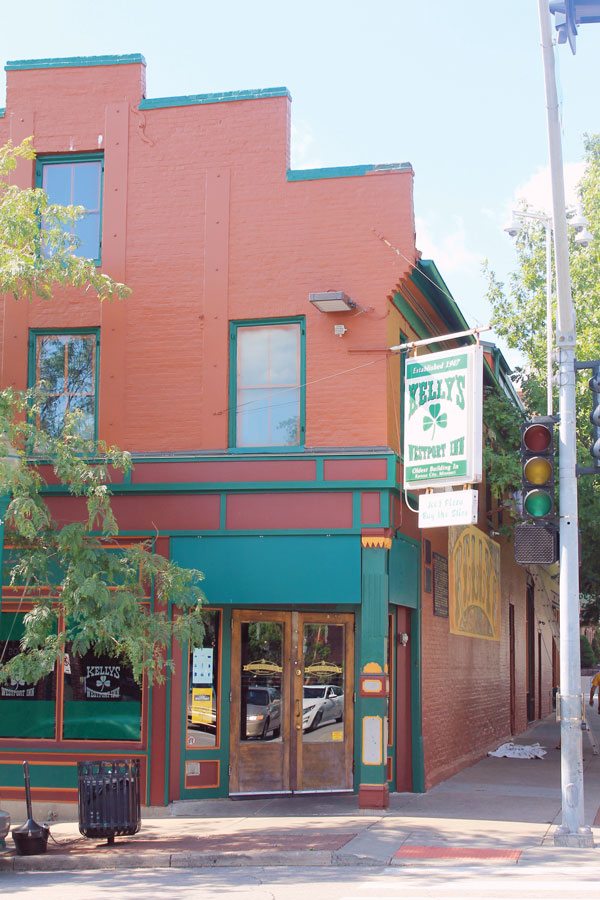
Kelly’s Westport Inn
Kansas City • 500 Westport Road • 8165615800 • KellysWestportInn.com
As the oldest building in Kansas City, Kelly’s Westport Inn has been home to many businesses over the years, including a trading post owned by Albert Boone, grandson of Daniel Boone. Situated along the Santa Fe Trail, the building was an important stop for many westward travelers. After Prohibition was repealed in 1933, the owner converted it to a saloon. It has remained that way ever since. Keep an eye out for the ashes of a previous owner in a bottle behind the bar.
In 1947, Irishman Randal Kelly hired on as a bartender at the Westport Inn. Kelly became an owner of the inn and was beloved by his adopted city as a man in possession of a warm heart and quick wit. The bar developed a loyal following and inspired many legends. It’s said that on one St. Patrick’s Day in the early 1960s, the visiting Lord Mayor of Dublin couldn’t even enter the inn through the boisterous crowd; Kelly had to greet him on the sidewalk.
Kelly was known for his generally friendly disdain of high society, which he called “the foam on top of the beer.” Renowned American painter Thomas Hart Benton—who famously said he preferred his art be displayed “in bawdy houses and saloons” because that’s where real people were—was a customer at Kelly’s.
The Irish word for welcome, failte, greets customers of the inn, echoing Kelly’s unpretentious hospitality. Kansas City Mayor Richard Berkley declared March 16, 1984, as Kelly Day in honor of the saloonkeeper’s generosity and place in Kansas City culture.
These days, a third generation of Kellys runs the show. They still carry through the tradition of warm welcomes and camaraderie. Bands and the occasional DJs fill the bar with music on most weekends, playing to dancing crowds. The bar is open for revelry seven days a week.

O’Malley’s Pub & Weston Brewing Company
Weston • 500 Welt Street • 816-640-5235 • WestonIrish.com/omalleyspub
In many ways, Weston was the town that almost was. The golden days of Weston were between 1837 and 1860 when it was the last stop before the great wilderness of the western frontier. Before the fickle Missouri River shifted its banks in another direction, it was the second-largest city in Missouri.
There is no more unique bar in Missouri—if not the whole of the Midwest—than Weston Brewing Company, also known as O’Malley’s Irish Pub. O’Malley’s calls itself a pub—not an all-purpose tavern— but its rich history is worth including.
German immigrant John Georgian built the lagering cellars that house the underground pub in 1842. Constructed of hand-cut stones, the vaulted cellars of Weston Brewing Company were dug 58 to 60 feet into the earth and were among the first lagering cellars in the nation. Using ice from frozen rivers in the winter, the buried cellars allowed for precise temperature control during the brewing process. The slaves who built the cellars left hatch marks that are still visible in the stones. Usually, Georgian paid the slaves a salary for their work and even used the cellars as part of the Underground Railroad, where runaways mingled with his enslaved people until they could get away safely.
Over the years, the cellars have changed hands and have served many uses. At one time, the bottom cellar was used to house hogs; another time it was a sort of city dump.
A fire claimed the lives of several people in 1860, and it’s rumored their ghosts haunt the underground. Staff might tell you that the cellars are haunted, and some employees are reticent to walk the tunnels alone.
The old vaulted ceilings of the bar curve down, adorned with antique pageantry. The high ceiling offers great acoustics. Musicians such as Bob Reeder, an Irish folk singer, often play in the large vault.
The bar today features a selection of Irish whiskey, as well as a wide range of beer brewed on-site, cocktails, and wine. The kitchen offers sandwiches, nachos, burgers, and bangers. History and beer fans can go on brewery tours, available three times an afternoon on Saturdays. Tour reservations are encouraged.
Related Posts
March 11, 1980
The floating McDonalds on the St. Louis riverfront opened on this date.
Earthly Creations
They say that life is what happens while you’re busy making plans. We’re pretty sure you’d get no argument from Sandra Zak.

